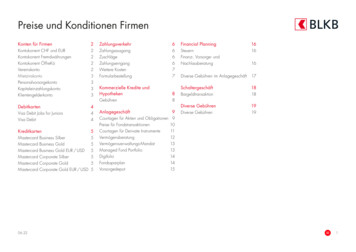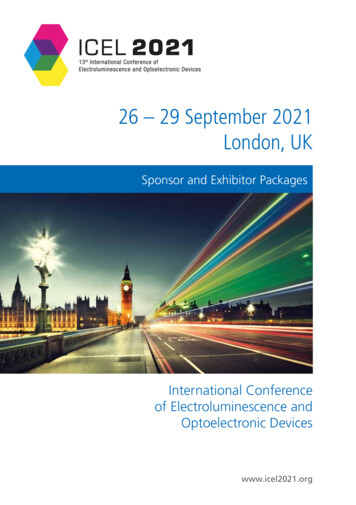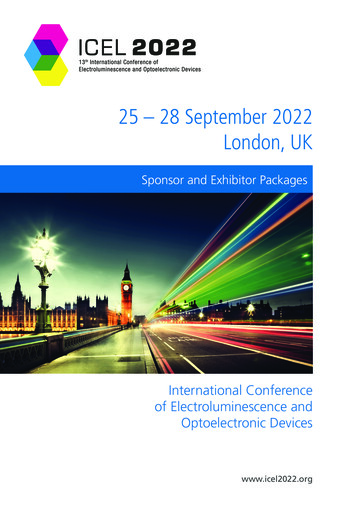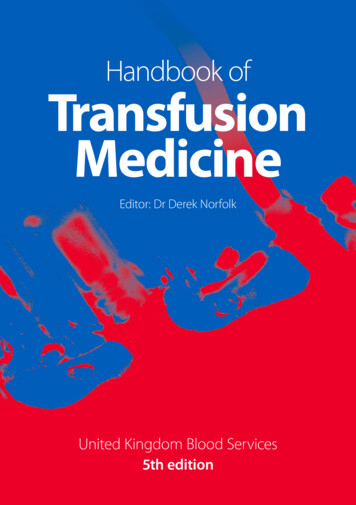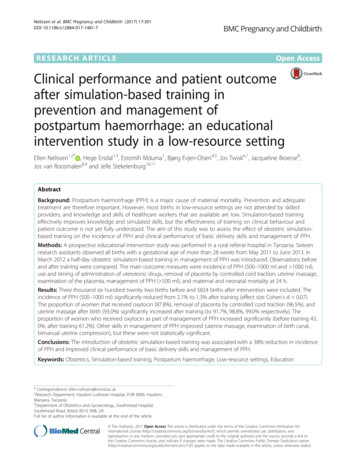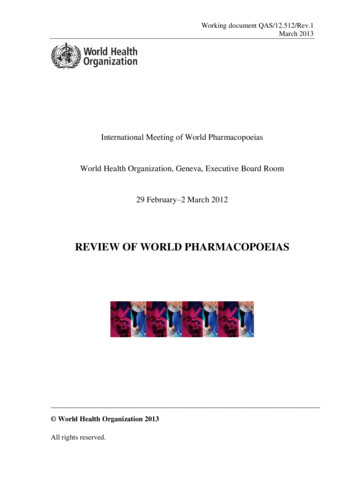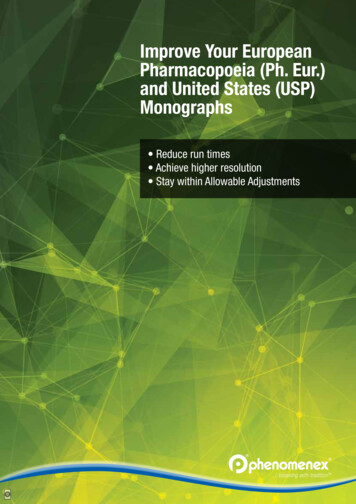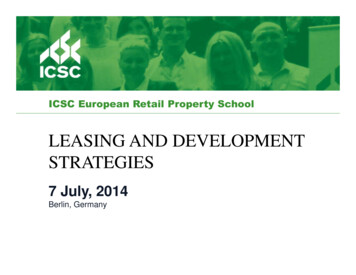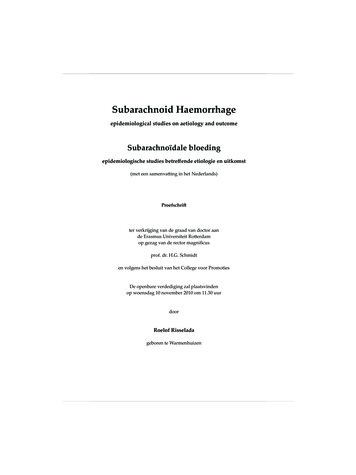
Transcription
Subarachnoid Haemorrhageepidemiological studies on aetiology and outcomeSubarachnoïdale bloedingepidemiologische studies betreffende etiologie en uitkomst(met een samenvatting in het Nederlands)Proefschriftter verkrijging van de graad van doctor aande Erasmus Universiteit Rotterdamop gezag van de rector magnificusprof. dr. H.G. Schmidten volgens het besluit van het College voor PromotiesDe openbare verdediging zal plaatsvindenop woensdag 10 november 2010 om 11.30 uurdoorRoelof Risseladageboren te Warmenhuizen
Promotiecommissiepromotoren:prof. dr. M.C.J.M Sturkenboomprof. dr. A. van der Lugtoverige leden:prof. dr. M. Hofmann-Apitiusprof. dr. G.J.E. Rinkelprof. dr. E.W. Steyerbergauthor: Roelof RisseladaPrinted by: Ipskamp Drukkers, Enschede, The NetherlandsThe work described in this thesis was conducted at the Department of MedicalInformatics at the Erasmus MC University Medical Center, Rotterdam. Theresearch was conducted within the @neurIST project, ‘@neurIST, integratedbiomedical informatics for the management of cerebral aneurysms’ (www.aneurist.org), funded by the European Commission 6th Framework Programme.
voor Mies
Table of ContentsChapter 1General introductionChapter 2Incidence, treatment, and case-fatality of subarachnoidhaemorrhage in the Netherlands713Chapter 3 Risk3.1 Withdrawal of statins and risk of subarachnoid haemorrhage3.2 Platelet aggregation inhibitors, vitamin K antagonists,and risk of subarachnoid haemorrhage3.3 Oral contraceptives and risk of subarachnoid haemorrhage3.4 Genome-wide association study of intracranialaneurysm identifies three new risk loci232433Chapter 4 Prediction4.1 Prediction of 60-day case-fatality after aneurysmalsubarachnoid haemorrhage4.2 Prediction of two month modified Rankin Scalewith an ordinal prediction model in patients withaneurysmal subarachnoid haemorrhage6970Chapter 591General discussion4555796.1 Summary1036.2 Samenvatting107References111PhD Portfolio123Curriculum vitae125List of publications127
Chapter 1General introduction
8 Chapter 1General aspects of subarachnoid haemorrhageEpidemiologySubarachnoid haemorrhage (SAH) is bleeding into the subarachnoid space ‒ thearea between the arachnoid membrane and the pia mater surrounding the brain.SAH occurs spontaneously or can be caused by traumatic injury of the head.Spontaneous SAH is caused by rupture of an intracranial aneurysm in 85 percentof cases [1]. In this thesis we consider both spontaneous SAH in general and inseveral studies aneurysmal SAH specifically.Reliable knowledge about the risks of (aneurysmal) SAH in differentpopulations will help in planning, screening and prevention strategies and inpredicting the prognosis of individual patients. The overall incidence of SAH is ingeneral between 5 and 10 per 100,000 person years. However, in Japan and Finlandrates are as high as 20 per 100,000 person years [2]. This can partly be explainedby genetic and environmental differences between these and other countries [3, 4].The incidence increases with age; and from midlife onwards incidence is higherin women than in men [2]. The reasons for this higher incidence in women are notclear, but hormonal factors (including hormonal medication) have been suggestedas a possible explanation [5,6].Diagnosis and TreatmentSudden headache is the most characteristic symptom of SAH; in approximately75 percent of patients, the onset is within seconds [7]. Often, the headache isaccompanied by nausea and vomiting. Headache from SAH is diffuse anddescribed by patients as by far the most severe headache they have ever had. It is,however, not the severity, but the suddenness of onset, which is the characteristicfeature ‒ but a feature that patients often forget to mention because it is theseverity of the pain for which they seek medical attention [1]. On admission twothirds of all patients have depressed consciousness, of whom half are in coma [8].The patient might regain alertness and orientation or might remain with variousdegrees of lethargy, confusion, or agitation. An acute confusional state can occurand be misinterpreted as psychological in origin [9, 10]. Neck stiffness is a commonsymptom, caused by the inflammatory response to blood in the subarachnoidspace. Neck stiffness takes a couple of hours to appear and might not develop atall in deeply unconscious patients, or in patients with minor SAH [11]. Therefore,absence of neck stiffness can never exclude the diagnosis of SAH in a patient withsudden headache [1].The first investigation when SAH is suspected is computed tomography (CT)to visualize the SAH. A second step is to examine the presence and localisation ofintracranial aneurysms. This can be done by either digital subtraction angiography(DSA) or CT-angiography (CTA). Unruptured intracranial aneurysms (UIA) arepresent in approximately 2 percent of the general population [12, 13]. The risk of
General introduction 9rupture of an UIA, leading to an aneurysmal SAH is around 2 percent per year[12]. In case of an aneurysm as cause of the SAH, the aneurysm must be treatedto prevent rebleeding. The aim of treatment is to exclude the aneurysm from theblood circulation. That aim can be achieved by placing a clip over the neck of ananeurysm during a neurosurgical procedure, or by filling the aneurysm with a coilduring an endovascular procedure [14-16]. Other less frequently used treatmentmodalities comprise wrapping, stenting, or balloon occlusion [17-19]. Causes ofspontaneous SAH from other origins include other vascular lesions, inflammatoryand non-inflammatory lesions, tumours, and drug or substance use [1, 20]. Patientsin whom no cause is found do not undergo any treatment and usually have anexcellent prognosis [21].AetiologySystematic reviews have been performed to present current knowledge on riskfactors for SAH in a systematic way [22]. Established modifiable risk factors forSAH are hypertension, smoking, and excessive alcohol intake, all of which moreor-less double the risk [23]. However, their roles in underlying mechanisms of SAHoccurrence are poorly understood and are essentially limited to their statisticalassociations [24]. Another group of modifiable risk factors consists of medication.A wide range of chemical substances has been examined with regard to risk ofstroke or SAH [6, 23, 25-28]. However, in several studies it remained unclearwhether and to what extent the drugs under study were associated specificallywith SAH, as this was not separated out [25, 29]. Other studies led to contradictingresults [23, 26]. To address some of the uncertainties from previous studies, weexamined in this thesis the association between SAH and three drug classes;statins, antithrombotics, and oral contraceptive pills (OCP).Statins affect the endothelium through increased nitric oxide (NO)bioavailability [30]. Withdrawal of statins causes a rebound effect leading toincreases in vascular event rates beyond that of the absence of prevention alone [27].This observed rebound effect has been attributed to the inhibition of endotheliumNO synthase (eNOS) mediated pathways by statins [27]. Withdrawal of statinsis supposed to impair the eNOS mediated tension regulation, which in turn maylead to short term increased stress on the vessel wall and risk of SAH.Use of antithrombotic agents has been associated with increased risk ofintracranial haemorrhage (ICH) [28]. It remains unclear whether and to whatextent these antithrombotic agents are associated specifically with SAH, as this isregularly not separated out [25, 29].Since incidence patterns of SAH differ between men and women in differentage categories, hormonal influences have been suggested [2]. Others concludedthat OCP use promotes endothelial dysfunction [31].Genetic factors account for approximately 10 percent of spontaneous SAH[32]. Most research in the genetic field has focussed on genetics of intracranial
10 Chapter 1aneurysms. Candidate genes for intracranial aneurysms identified thus far includegenes coding for elements of the extracellular matrix [33], endothelial cells [34],and cell cycle progression [35]. The exact mechanisms leading to rupture of anintracranial aneurysm remain to be clarified. A plausible explanation is a peak inthe arterial blood pressure [1]. Such a peak can be caused by heavy physical exercise(including sexual intercourse) or substance use, e.g. cocaine [36-38]. However, inthe majority of SAH cases the exact reason for occurrence at a particular point intime remains unexplained [1].OutcomeCase-fatality after SAH has been estimated between 20 and 50 percent [39, 40].The percentage of persons dying before they reach a hospital has been estimatedbetween 10 and 15 percent [41, 42]. In those who survive the first episode of SAH,epilepsy develops after discharge in approximately five percent of patients [43,44]. Cognitive deficits and psychosocial dysfunction in the first year after SAHare common, even in patients who make a good recovery in terms of self care [4547]. Although improvement can be expected up to one and a half year after SAH,many former patients experience deficits and reduced quality of life 1 to 2 yearsafter SAH [48].Aims and outline of this thesisThe work in this thesis was conducted as part of the @neurIST project, a EuropeanCommission funded project focusing on integration of knowledge on intracranialaneurysms from molecular level up to population level. One of the overall aimsof the project was to develop an individualised prediction model that wouldallow predicting behaviour of an unruptured aneurysm and outcome of eventualrupture of an aneurysm. To reach this final aim, several intermediate questionshave to be solved. In this thesis we address several of these.The aim of this thesis is to provide answers to the following questions:1. What is the incidence and case-fatality of (aneurysmal) SAH in the generalpopulation?2. Can we estimate the association between prescribed drugs and the risk of(aneurysmal) SAH?3. Can we identify new genetic risk loci for intracranial aneurysms?4. Which patient and aneurysm characteristics predict outcome after aneurysmalSAH?This introductory chapter gave a high level overview of already availableknowledge. We consider it to be desirable to obtain further knowledge on several
General introduction 11aspects of (aneurysmal) SAH. Although much has been written on clipping andcoiling of intracranial aneurysms, it remains to be established how these treatmentmodalities are applied in real life clinical settings, and what the outcome is. Inthe field of aetiology, systematic research in the association between drugs and(aneurysmal) SAH lacks. The role of genetics also needs to be elucidated more. Tofinally reach the aim of individualized prediction models, effort has to be put indevelopment of prediction models for various outcomes in different stages of thedisease.In chapter 2 the occurrence of (aneurysmal) SAH in the general populationis examined as well as case-fatality and treatment modalities that were applied.The incidence rate tells us how many SAHs occur per 100,000 persons per year.Why these SAHs occur remains to be established, since the exact mechanismsunderlying SAH remain incompletely understood. However, there are indicationsthat external factors -amongst which drug use- play a role in the aetiology of SAH.Therefore, in chapter 3 we investigated several risk factors for (aneurysmal)SAH. The most important were drugs whose mode of action was thought tointeract with the physiology of blood vessels -more specific: arteries- and thereforemay play a role in the aetiology of SAH. Statins are protective for cerebrovascularevents and withdrawal of statins causes a rebound effect leading to increases invascular event rates beyond that of the absence of prevention alone [27]. Thisobserved rebound effect has been attributed to the inhibition of endothelium NOS(eNOS) mediated pathways by statins [27]. Withdrawal of statins is supposedto impair the eNOS mediated tension regulation, which in turn may lead toshort term increased stress on the vessel wall and risk of SAH. To investigatethis potential mechanism we studied the association of statin withdrawal andSAH in chapter 3.1. Antithrombotic agents have been associated with increasedrisk of intracranial haemorrhage [28, 49]. Since their role in precipitating SAHremains to be elucidated, we studied the relation between SAH risk and the useof antithrombotic agents in chapter 3.2. A specific subgroup of the population wasunder study in chapter 3.3; since quite some time use of oral contraceptive pills(OCP) has been associated with vascular pathology, amongst which stroke. Also,hormonal factors have been suggested to explain sex differences in SAH incidence[5, 6]. To investigate whether there was an effect on SAH risk in OCP users, westudied the association in a population of women under 50 years of age. Chapter3.4 describes the work of a consortium on genetic factors that are associated withaneurysmal SAH. Genetic factors were investigated by pooling genetic data frompatients in several populations including data collected by us from IPCI andErasmus MC cases and controls.In chapter 4 we were interested in factors that actually predict outcome ofaneurysmal SAH. Prediction of outcome may support clinical decision makingand may provide realistic and evidence based expectations to patients andrelatives. Predictions may also be used to classify patients according to prognostic
12 Chapter 1risk, which may be useful to compare outcome between different patient series,to study treatment results over time, or to stratify patients for randomised clinicaltrials. We developed a prediction model for outcome of aneurysmal SAH based onclinical information that is already available in an early stage of hospital admission.The prediction model was based on a re-analysis of data from the ISAT study,one of the larger clinical trials in the fields of aneurysmal SAH. In chapter 4.1 wepresent a prediction model for 60 day case-fatality in patients with an aneurysmalSAH who were in equipoise with regard to best treatment option. As potentialpredictors we investigated clinical and neuroradiological characteristics of patientand aneurysm. After model selection and internal validation, we developed aprediction model based on two clinical and two neuroradiological characteristics.To extend the usability of our model we expanded the outcome from 60 day casefatality to outcome on an ordered clinical outcome scale; the modified Rankinscale. Results of this model development exercise are presented in chapter 4.2.The significance and methodological issues of the studies presented in thisthesis will be discussed in chapter 5. Findings from this thesis will we summarizedin chapter 6.
Chapter 2Incidence, treatment, and case-fatality of subarachnoidhaemorrhage in the Netherlands
14 Chapter 2AbstractBackground: Subarachnoid haemorrhage (SAH) is a devastating disorder and inthe majority of cases caused by rupture of an intracranial aneurysm. No actualdata are available on the incidence of SAH and aneursymal SAH (aSAH) in theNetherlands and little is known about treatment patterns of aSAH. Our purposewas therefore to assess the incidence, treatment patterns, and case-fatality of (a)SAH within the Dutch general population.Methods: Two population based data sources were used for this retrospectivecohort study. One was the nationwide hospital discharge registry (LMR). Caseswere patients hospitalized for SAH (ICD-9-code 430) in 2001-2005. The secondsource was IPCI, a medical record database allowing for case validation. Caseswere patients with validated (a)SAH in 1996-2006. Incidence, treatment, and casefatality were assessed.Results: The incidence rate (IR) of SAH was 7.12 per 100,000 PY (95%CI: 6.94-7.31)and increased with age. The IR of aSAH was 3.78 (95%CI: 2.98–4.72). Women hada twofold increased risk of SAH; this difference appeared after the fourth decade.SAH fatality was 30% (95%CI: 29-31%). Of aSAH patients 64% (95%CI: 53-74%)were treated with a clipping procedure, and 26% (95%CI: 17-37%) with coiling.Conclusion: SAH is a rare disease with substantial case-fatality; rates in theNetherlands are similar to other countries. Case-fatality is also similar as well asage and sex patterns in incidence.
Running titel 15IntroductionNon-traumatic subarachnoid haemorrhage (SAH) is a devastating event, witha case-fatality of around 30 percent [1, 40]. Incidence rates have been assessedin many countries and two patterns can be distinguished: countries with highincidence of around 20 per 100,000 person years (PY), such as Finland and Japan,and countries with low incidence of approximately 5-10 per 100,000 PY [2].Approximately 85 percent of SAH is a result of rupture of an intracranialaneurysm (IA), although it is not clear whether this percentage is the same overdifferent age and sex categories [1]. Causes of spontaneous SAH from other originsinclude other vascular lesions, inflammatory and non-inflammatory lesions,tumours, and drug or substance use [1, 20].The diagnosis of SAH is primarily based on CT imaging and lumbar puncture,eventually followed by angiography; not only to identify an aneurysm as potentialcause of the haemorrhage, but also to study the anatomical and morphologicalconfiguration of the aneurysm in relation to adjoining arteries, which allowsoptimal treatment selection [1]. Treatment of aneurysmal SAH (aSAH) consistsmainly of either neurosurgical clipping or endovascular coiling. Other lessfrequently used treatment modalities comprise wrapping, stenting, or balloonocclusion [17-19].Given the fact that no recent data on age and sex specific incidence of SAHand aSAH in the Netherlands are available, we assessed the incidence of bothconditions in the general Dutch population. Moreover, we studied case-fatality,and treatment modalities applied to aSAH patients. This was done in twopopulation based databases; a national discharge database and a smaller medicalrecord database which allowed for assessment of the presence of an aneurysm andtreatment modality.Materials and methodsLMR databaseHospital discharge diagnoses were obtained from the national registry of hospitaladmissions, the National Medical Registration (LMR), containing information onall admissions in general and academic hospitals throughout the Netherlands (basepopulation: approximately 16.5 million subjects). The International Classificationof Diseases, Ninth Revision, Clinical Modification (ICD-9-CM) was used to classifyhospital admissions in the Netherlands during the study period. Data used includehospital code, patient sex and age, ICD-9-CM coded discharge diagnosis, up to 9diagnostic or therapeutic procedures (coded according to the LMR Classificationof Diagnostic, Therapeutic, and Surgical Acts), and discharge destination (‘home’,‘old people’s home’, ‘nursing home’, or ‘died in hospital’).
16 Chapter 2SAH cases were all admissions with a primary discharge diagnoses (ICD-9-CM)430 (subarachnoid haemorrhage) during the years 2001 through 2005. Case-fatalitywas defined as dying in the hospital during hospitalization for SAH.The denominator for the incidence calculation was the annual mid-yearpopulation size as obtained from Statistics Netherlands (CBS, accessed throughhttp://www.cbs.nl, as of June 7th, 2010).IPCI databaseThe Integrated Primary Care Information (IPCI) database is a general practiceresearch database with electronic medical record data currently comprising morethan one million patients throughout the Netherlands. The patient populationis representative of the Dutch population regarding age and sex [50]. Details ofthe database have been described elsewhere [51]. The system complies with theEuropean Union guidelines on the use of medical data for research and has beenproven valid for epidemiological studies [51]. The Scientific and Ethical AdvisoryGroup of the IPCI project approved the study (Project No. 07/02). The databaseallows for validation of disease by requesting additional information from thegeneral practitioner by questionnaire and copies of original specialist letters.Potential cases of SAH and aSAH were identified from the IPCI databaseusing an extensive narrative search. All cases were validated by manual review ofthe electronic medical record and subsequently by review of a questionnaire andspecialist letters that were obtained from the GP for each case. The validity of thediagnosis was judged by a medical doctor (R.R.) and a neurologist (D.W.J.D. orF.K.). The judgment of the neurologist was decisive. Case-fatality was defined asdying within a period of 30 days after the date of onset of SAH (index date).The denominator for the incidence calculation was the number of personyears in the IPCI database during the study period (January 1996–September2006).Statistical analysisThe incidence rate of SAH and aSAH was calculated by dividing the number ofincident cases (numerator), by the total number of accrued person years (IPCI)or persons (LMR) in the study population (denominator). Incidence rates (IR)were calculated in age and sex categories. Confidence intervals (95% CI) for eachestimate were based on the Poisson distribution. To estimate case-fatality of aSAHin the IPCI database, Kaplan-Meier survival analysis was used. Incidence rateswere used to calculate rate ratios of SAH and aSAH between females and males.All analyses were performed using SPSS software version 15.0 (Chicago, Ill., USA).
Running titel 17ResultsLMR: SAHIn the period 2001 to 2005 a total of 5,769 patients (64% female) were admittedto Dutch hospitals with discharge diagnosis ‘subarachnoid haemorrhage’. Theoverall nationwide incidence rate of SAH was 7.12 per 100,000 person-year (PY)(95% CI: 6.94-7.31) (Table 1). The incidence rate rapidly increased with age (Table1, Figure 1). The overall incidence rate ratio (IRR) of SAH for women compared tomen was 1.72 (95% CI: 1.63-1.81). This differential risk occurred gradually and wasmost pronounced in the fourth and fifth decade (Table 1, Figures 1). Case-fatalityfor SAH during hospitalization was 30 percent (95% CI: 29-31%), and increasedwith age, but did not differ between males and females (Table 1).Figure 1. Sex Specific Incidence Rates of SAH in 5 year age bands in LRM data. Solid linesare estimated rates, dashed lines the 95% confidence bands; grey line for women, blackline for men.IPCI database: SAH and aSAHIn the initial source population of 488,118 persons, 107 incident cases of SAH (70%female) were identified after validation (Table 1). Based on these data the observedcrude rate was 5.53 per 100,000 PY (95% CI: 4.56-6.66) (Table 1), which translates toa rate of 6.48 per 100,000 PY in the Netherlands after standardization to the Dutchage and sex distribution. The incidence rate increased with age and was similar tothe LMR rates up until 64 years; rates were lower after that (Table 1).
132 80869366576965 to 79 011.79-12.621.23-1.4595% 15fatality* IPCI SAHcases 2.3412.141.28IR* during hospitalization; § within 30 days, using Kaplan-Meier survival analysis.208740 to 64 4035252765 to 79Female121840 to 64 402182095MaleMale3674FemaleSex4981396 80330565 to 7957040 to 64 40AgeLMR SAH IRcases 5% CITable 1. Incidence rates of (a)SAH by age and sex in the LMR and IPCI 280.52.195.3307.48.621.02fatality§ IPCI aSAH IRcases .30.56-1.7395% CI0005.611.15.911.107.79.14.28.3fatality§18 Chapter 2
Running titel 19In 68 percent of all IPCI derived SAH cases (n 73) an aneurysm had been diagnosed(95% CI: 59-76%). The proportion of aneurysms as cause of SAH diminished withage (Figure 2).The crude observed incidence rate of aSAH was 3.78 per 100,000 PY (95% CI:2.98-4.72), which would imply a rate of 4.26 per 100,000 for the Dutch population(age and sex standardized). Of the patients with an aneurysm the majority wastreated by means of a neurosurgical clipping procedure (64%, 95% CI: 53-74%)and 26 percent (95% CI: 17-37%) by means of endovascular coiling. Five patients(7%) did not receive any treatment because of rapid deterioration and death. In theremaining 3 percent we could not find information on procedures.Kaplan-Meier survival analysis showed that 26 percent of SAH patients diedwithin 30 days (95% CI: 17-34%) (Table 1). Case-fatality in aSAH patients was5.6 percent (95% CI: 0.31-10.9) (Table 1). Risks could not be estimated in separatetreatment groups due to low numbers.Figure 2. SAH and aSAH incidence rate by age (IPCI database)DiscussionWe used two different population based databases: a hospital discharge databaseand an electronic medical record database to assess the occurrence, treatment,and case-fatality of SAH and aSAH in the Netherlands. We used both sourcesto profit from the size in the LMR and the quality of information and validationopportunities in the IPCI database. By using these data we revealed variousimportant observations: first, the crude national incidence rate of SAH was
20 Chapter 2between 5-7 cases per 100,000 PY, putting the Netherlands in the low incidencecountries. Second, about 70 percent of SAHs were of proven aneurysmal originand this varied slightly by age (lower in high ages). Third, case-fatality of SAH washigh: around 26 percent within one month and this increased with age. Fourth, astriking age and gender pattern was observed in the incidence rates. The incidencerates increased rapidly after age 40, but mostly so for women. Fifth, the incidencerates for aSAH increased less rapidly with age than for SAH overall, suggestinga difference in the percentage of aneurysms by age. Sixth, the majority of personswith an aSAH underwent surgical clipping.Our findings on the rates and case-fatality were similar to previously publishedpopulation-based studies from other countries. However, often the rates for aSAHare not available. The assumption that 85 percent of SAH is based on aneurysms,may therefore not hold true and certainly not for all age categories. Some of theprevious studies have investigated sex specific rates and age-gender interaction,and also reported higher rates in women; however the age dependent change inincidence for women compared to men was reported few times. The reasons forthe overall higher incidence in women are not clear, but hormonal factors would bea first logical option [5, 6]. Our finding that the preponderance of women becomesevident around the menopause, during which changes in oestrogen levels takeplace, further supports this suggestion. Previously, an increase in cardiovascularrisk among women after menopause has been recognized [52], for which decliningendogenous oestrogen levels have been held responsible [53]. Declining levelsof oestrogen might lead to impaired activation of nitric oxide [54], which ishypothesized to be an important factor in the aetiology of SAH through its effectson the vascular endothelium [55, 56].Being based on observational data the results of our study should be interpretedin the light of potential limitations, such as selection bias and information bias.Selection bias in assessment of rates and case-fatality is negligible in this studysince we used population based databases. Selection may have occurred becausevalidation of the discharge diagnoses for the LMR was done only in our hospital.Results of this validation may not be generalizable to all other centres. Thus, themost important limitation is misclassification of the outcome. For a patient to beconsidered a case in our study, the diagnosis SAH had to be made. Patients whodied before reaching medical care were not included in the LMR estimate and itis highly likely that they were also missed in the IPCI database due to lack of aproper diagnosis and specialist information. Previous studies have estimated thepercentage of persons dying outside hospitals to be between 11 and 13 percent [41,42]. This means that the true incidence is potentially 10 percent higher than in ourestimations (up to 8 per 100,000 PY). Another potential limitation is the accuracyof the registered diagnosis in the LMR database. Validation of discharge diagnosesin our own hospital showed that 10 percent of the cases were false positive (datanot shown). Inclusion of these false positive cases in incidence estimates would
Running titel 21lead to overestimation. In the IPCI database, false positives were unlikely, sincecases were validated. In both databases false negative misclassification has notbeen quantified. We think it is limited in the IPCI database as we applied a verysensitive search on codes and free text to identify potential cases and reviewed allpotential cases manually.Misclassification of mortality was an issue in the LMR database. Sincethe database only captures data during hospitalizations and is not linked toa death registry, it is not possible to obtain mortality data of patients once theyare discharged from the hospital. We therefore chose to report on the mortalityduring hospital admission only. Nonetheless, the case-fatality is comparable tothe case-fatality as estimated from the IPCI database that does capture follow-upand mortality data. This implies that most cases die often immediately and mostlyduring hospitalization. Case-fatality o
genes coding for elements of the extracellular matrix [33], endothelial cells [34], and cell cycle progression [35]. The exact mechanisms leading to rupture of an intracranial aneurysm remain to be clari Þ ed. A plausible explanation is a peak in the arterial blood pressure [1]. Such a peak can be caused by heavy physical exercise
